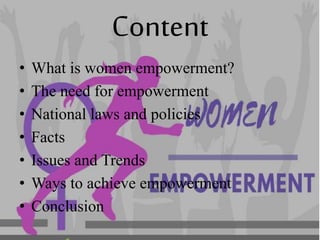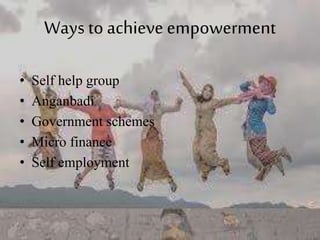Women empowerment
- 1. Women Empowerment Submitted by- Mahak Jain BA(JMC) Submitted to- Ms. Khooshbu
- 2. Content • What is women empowerment? • The need for empowerment • National laws and policies • Facts • Issues and Trends • Ways to achieve empowerment • Conclusion
- 3. What is women empowerment? • Women empowerment is the process of increasing the capacity of the individuals or groups to make choices and to transfer those choices to desired actions and outcomes. • It is to motivate and develop women by promoting their participation in all areas and sectors, to build stronger economies, improve their quality of life and bring gender equality with equal amount of opportunities.
- 4. The needfor empowerment The problems faced by women can be seen in every sector i.e. economical, social, political, educational. Some of them are- • Gender discrimination • Women education • Dowry • Child marriage • Atrocities on women: With their age they have been raped, kicked, killed, subdued and humiliated almost daily.
- 5. National laws and policies • One third reservation for women in the urban and local self government. • Free and compulsory education- a right for all children between the age group of 6-14 years. • The constitution empowers the state to adopt measures of positive discrimination in favor of women. • National policy of women empowerment(2001)- advancement and development and empowerment of women. • The national commission for women (1990)
- 6. Facts • Women comprises 48.3% of India's population but only 26.1% of employed persons( Indian census 2011) • 80% of rural women are engaged n agricultural production but only 9% own land. • 55% of women perceive violence as their marriages. • 75% of battered women commit suicide.
- 7. Issues and Trends Trapped in social and cultural practices • Powerless to make essential life choices, dominant behaviors and mindsets, inequalities within households. Education • Poor infrastructure, lack of non-formal education system. Economic participation • Informal infrastructure, low skills, risk of exploitation, legal status.
- 8. Ways to achieve empowerment • Self help group • Anganbadi • Government schemes • Micro finance • Self employment
- 9. Ways to empower women • Creating an enabling environment. • Changes in attitudes and relationship between gender. • Training teachers and public workers to excel. • Help them to become business leaders. • Help them to get good and better education. • Help them to fight against crime and encourage them to take step for themselves. • Engaging youth to give information and to support women empowerment
- 10. Conclusion Women represents half of the worlds population, and gender inequality exists in every nation on the planet. Until women are given the same opportunities that men have, entire societies will be destined to perform below their potentials. The greatest need of the hour is change of social attitude to women.









